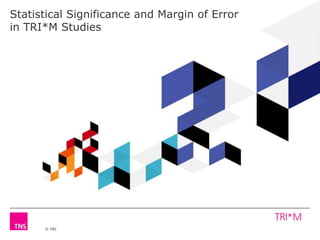Trim statistical significance and margin of error 2013
•Als PPTX, PDF herunterladen•
1 gefällt mir•536 views
Melden
Teilen
Melden
Teilen

Empfohlen
Empfohlen
Weitere ähnliche Inhalte
Was ist angesagt?
Was ist angesagt? (20)
Probability and statistics (frequency distributions)

Probability and statistics (frequency distributions)
2.1 frequency distributions for organizing and summarizing data

2.1 frequency distributions for organizing and summarizing data
3 goals calculate the arithmetic mean, weighted mean,

3 goals calculate the arithmetic mean, weighted mean,
Hierarchical clustering and topology for psychometric validation

Hierarchical clustering and topology for psychometric validation
Data Science Meetup: DGLARS and Homotopy LASSO for Regression Models

Data Science Meetup: DGLARS and Homotopy LASSO for Regression Models
Ähnlich wie Trim statistical significance and margin of error 2013
Ähnlich wie Trim statistical significance and margin of error 2013 (20)
Measures of Central Tendency, Variability and Shapes

Measures of Central Tendency, Variability and Shapes
Statistical ProcessesCan descriptive statistical processes b.docx

Statistical ProcessesCan descriptive statistical processes b.docx
Computing Descriptive Statistics © 2014 Argos.docx

Computing Descriptive Statistics © 2014 Argos.docx
Computing Descriptive Statistics © 2014 Argos.docx

Computing Descriptive Statistics © 2014 Argos.docx
STATISTICAL PROCEDURES (Discriptive Statistics).pptx

STATISTICAL PROCEDURES (Discriptive Statistics).pptx
Trim statistical significance and margin of error 2013
- 1. © TNS Statistical Significance and Margin of Error in TRI*M Studies
- 2. © TNS Statistical Significance and Margin of Error in TRI*M Studies 2 Generally, all standard rules for statistical significance also apply to TRI*M studies. In order to determine the level of statistical margin the following parameters have to be taken into account: Sample size Customized sample designs (e.g. stratified sampling of different customer segments) Size of universe Standard deviation Significance level The mathematical calculation of the statistical margin of error for the TRI*M Index for various sample sizes is based on: Normal distribution of TRI*M Index Infinite universe Significance level of 95%, 90% and 80% The challenge is to determine the effect of high quality sample designs. We therefore calculate the standard deviation from all TRI*M Indices recorded in the TRI*M database. All these scores are based on highly customized sample designs of our customer research programs
- 3. © TNS Statistical Significance and Margin of Error in TRI*M Studies 3 The standard deviations for the following error rates for the TRI*M Index are calculated from the TRI*M Database that includes more than 17,000 TRI*M Customer Retention studies with more than 15 Mio. TRI*M Customer Retention interviews for 1,600+ companies. Most importantly, in order to apply these error rates to TRI*M Index comparisons over time it is absolutely essential to keep the sample design stable and robust from wave to wave Any changes in the design impact the index and error rates! Sample Size Confidence Coefficient 95% 90% 80% n = 30 +/- 10.7 +/- 9.0 +/- 7.0 n = 50 +/- 8.3 +/- 7.0 +/- 5.4 n = 75 +/- 6.8 +/- 5.7 +/- 4.4 n = 100 +/- 5.9 +/- 4.9 +/- 3.8 n = 200 +/- 4.2 +/- 3.5 +/- 2.7 n = 300 +/- 3.4 +/- 2.8 +/- 2.2 n = 500 +/- 2.6 +/- 2.2 +/- 1.7 Example: In case of a sample size of n=200, the „true“ TRI*M Index lies with a probability of 90% within a range of +/- 3.5 points
- 4. © TNS Significant vs. meaningful differences 4 Statistical significance: In statistics, a result is called statistically significant if it is unlikely to have occurred by chance. Statistical significance heavily depends on the number of respondents in a survey. Example: In a survey with n=8,000 respondents, a difference in the TRI*M Index (e.g. between two waves of the survey) of 0.5 points can be considered as significant on a 90% significance level. This means that with a probability of 90% (or more), the TRI*M Index in the two groups (e.g. waves) really is different (= not equal). But a significance does not give any information about the extent of this difference. Meaningful differences: A difference in results is called meaningful if it is of (business) relevance for the company. The question, whether a difference in the TRI*M Index is meaningful or not, is completely independent of the number of respondents. In the example, the difference in the TRI*M Index of 0.5 would be statistically significant (= not occurred by chance), but the difference is small enough to be utterly unimportant. The company will not perceive any difference in customer behaviour. For the TRI*M Index, a difference of 3 points can be considered as meaningful The use of the word significance in statistics is different from the standard one, which suggests that something is important or meaningful
